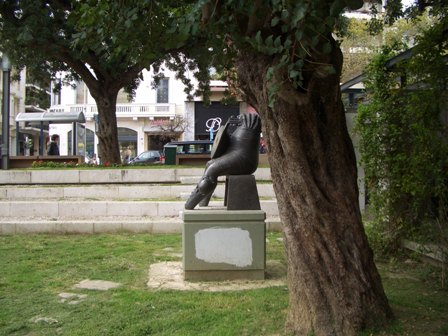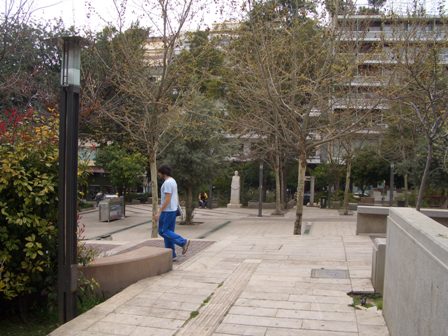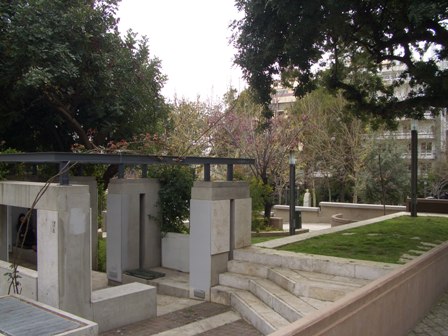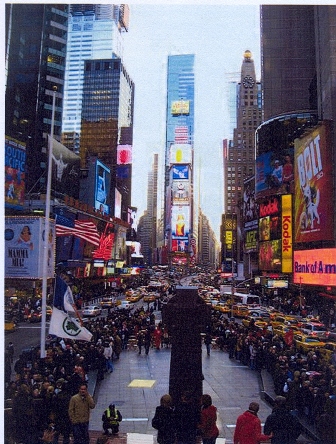8. Agora - Surrealists and the Monument
|
Human Matrix |
Mapping of Cultural resources |
Cultural planning |
Implementation |
Recommendations |
|
|
8. Agora – Surrealists and the Monument |
8.1 Squares and places |
8.2 Breathing spots |
8.3 Encounters at certain places: Time Square |
8.4 Interfaces within the city: urbanity |
|
Agora as a term derives its meaning from Ancient Greece. Then the term had a double meaning, namely as a meeting place to discuss politics and as a market place where things are traded. Indeed, cities strive on bringing together people so that they can give shape to such laws which ward of violence (Derrida) and at the same time provide space so that people can engage themselves in a possible trading of goods and services. The latter includes knowing weights and what entails setting a fair price so that selling and buying of goods can be realized in accordance with what the city would regard as an encompassing just society. That would include watching over trade to ensure fair prizes and honest practices are upheld.
Indeed the aim of cultural actions should be linked to upgrading municipal services by not resorting to negative tools i.e. police control but to indirect positive stimuli. For good practices derives first of all from a honest culture. If everyone wishes to uphold the reputation of the city, then everyone ensures that no one, stranger or local citizen is cheated and that all resources are distributed in a fair manner. After all there should be no grave inequality in society. The latter would undermine not only free access to the market. Equally it would make support for cultural development at best one sided i.e. in favor of the already established and therefore only to the disadvantage of those in need of cultural support to be able to take advantage of developments in the city.
To remember democracy in Greece was not just a mere ideal but was brought about by deliberate reforms. The latter were designed to cut especially the power of those who were growing stronger day by day. These reforms were needed before it would be too late to challenge those becoming more powerful at the disadvantage of all others.
That democratic quality differs greatly from the kind of power exercised, for example, by the Bush administration in the United States (2000 – 2008) insofar as tax cuts for the richest people made the latter even more powerful. It has put not merely the US administration, but all cities and states at risk to depend solely upon these all powerful holders of great wealth. The latter were put in that position by a clever increase of their enormous purchasing power. It has seen a reproduction of wealth at great cost, including an inefficient war economy and many more ending up in unemployment and therefore poverty as a consequence of still greater discrepancies between rich and poor. To this has been added the woes of a global financial crisis hitting the world since 2007 altering the purchasing power and hence position of negotiation of all global players. Purchasing powers means a capacity to influence the economy by altering in their favor the flow of goods and services.
But to come back to the city level, if cultural planning is to make any sense at all, then it must favor creation and keeping alive of public meeting places. Any one sided approach in favor of mere mass or luxury consumption will not do. For if any attempt is made to create through a new cultural economy a modern like Agora, then the political culture of the city must ensure that citizens participate in the decision making process.
The crucial question is, however, to what extent can culture ensure that not one sided structures favor only certain groups and individuals, but that all citizens engage themselves in a power sharing scheme on the principal of all citizens are equal. Since culture is an expression of freedom, fear of power would already undermine that principle. It is, therefore, decisive to encourage freedom of expression in a political sense while at the same time it must not be confused with artistic freedom of expression. The latter requires always a distinct framework like a stage or gallery and to elevate citizens to the level of the imagination in order to be receptive to artistic expressions altering the notion of quality of life.
Hence cities should be restructured, culturally speaking, in a way that squares and places become breathing spaces of the city in order to allow for interesting encounters between people with the aim to substantiate the rather abstract concept of ‘space’ used by planners. [1]
If it this brings about new urban interfaces, it can give shape to the way people wish to be governed. Alone by creating themselves the arts and culture, they can realize a different participation because then there are no longer in doubt about what they are doing nor will their relationship to the city be based solely on attending any performances or on just visiting exhibitions. By engaging themselves in lively discussions and creative thought processes, they will substantiate life in the city.
As people from Barcelona advised Athenians once awarded the Olympic Games, the starting premise for giving shape to such world presentation is a belief in the city. Citizens will develop accordingly such culturally refined practices that then the main aim is not a better image for tourism nor some short term economic success, but a life in the city connected with a sense of democracy. By knowing what the city stands for in terms of inputs by all, all relationships shall be based on friendliness, openness, trust and all those other cultural values needed if informal and formal structures and organizations are to substantiate the political, economic, social and cultural cohesion of the city.
From the Agora to the Surrealists and the question of the monument
Kolonaki Square in Athens with Surrealist sculpture @HF
When speaking about a sculpture put in a public place, it is not necessarily a monument. For that other criteria apply. It is like the combination of stories and what amounts to be a piece dedicated to keep a certain memory over time alive, that is when monuments are erected or called for. Some have a general riding on a horse to commerate his contribution to a war gone through in the past. They are literally monumental. That says it all: their colossal embodiment of something beyond the human imagination and sense for proportion.
Public Monument in Paris (near Notre Dame) @hf
Others are more complicated and delicate at the same time for how to handle Ground Zero in New York when conflicts and disputes break out over whether or not there should be also a Muslim Centre where there used to stand the Twin Towers which came crashing down due to events of 911 or rather in a wish to avoid confusion on 11th of September 2001.
In Ancient Greece the Agora was not defined as a single institution to be more powerful and separate from the others, but it was linked to the Polis and the theatre. Unfortunately in today’s world the market rules apparently over everything, even if only a virtual replica of a fictitious reality to which politicians refer to for ideological reasons. They do so when they wish to confuse freedom with practices not to be questioned as if they are above the law. Only when the city finds a unique linkage between culture and economy, then the city takes on a distinct character and finds own answers to the economic challenges.
Governance based on the principles negotiated out at the Agora would mean such laws have to be passed that are based on an understanding as to what a specific economy of not only things or goods, but financial resources means for daily life. The way limits and constraints are set, that makes things possible. People feel at home when both the political decision making process and the economy resulting out of a specific market concept regards their needs and allows a flourishing of culture so as to become knowledgeable in how to sustain life in the city. That includes cultural planning since urban planning by itself cannot find that all important bridge between culture and economy. People will only through cultural mediation be in a position to appraise properly measures to be taken with regards to various issues the city faces e.g. education of its youth, avoidance of violence, removal of rubbish, good water management, active social and cultural life etc. When aware of all the constraints, then a city shall present through the knowledge all can share in recognition what difference it makes when done with care for people and their ‘real needs’.
A city becomes a cultural hub once it enables all institutions, including the market and life in the streets to qualify daily what are ‘real needs’. For unfortunately there are many kinds of needs often linked to things not really needed or to needs which arise out of artificially created problems. It is well known that people earn a living off the inefficiency of administrations in Italian or Greek cities. Artificial problems created by deliberate inefficiency – things work very well when you are prepared to bribe - force people to circumvent first of all real experiences. Then they risk to become victims of induced, if not artificial needs. This is something advertisement knows very well to do. It leads to an overall corruption of the mind. Once people start buying things they do not need in reality, their relationship to reality shall become distorted. A life in a city full of contradictions can be at the best only a slight corrective, provided the privileged do not lead a segregated life and the poor have a chance to escape life in permanent poverty. Equality is still a matter that all can sit down at one and the same table and eat together regardless of race, gender or occupation.
Corruption expresses itself through over consumption of everything not really needed to sustain life. It is, therefore, the task of culture to set the level and measures. Lately with the increasing reference to ‘cultural economy’, there has become into use ‘quality knowledge’ as part of the creation of markets for goods and services people did not know as of yet in terms of needs until these things started to exist. People communicated well enough before the invention of the mobile phone but now that this gadget is available, everyone uses it as public telephones disappear and real time becoming ever more important in how to conduct business but also when to respond to incoming news and information.
Time and space as defined concretely through a city’s venues, including streets and public squares, is based on culture if a matter of refined practices. That means a market cannot be set apart from holidays and the year round rhythms by which a city marks the end of the winter or the beginning of the carnival season. Some of these events are there by ritualized purposes with repetition being regulated by expectations and excitement linked to knowing a certain event shall be repeated again one year later. Others are more uplifting and unique if it gives the city a unique opportunity to uplift its entire motivation and everyone contributes towards painting anew their houses while the streets are cleaned with greater care then usual. That was the case in Athens when preparing for the Olympic Games in August 2004. Such special occasions cannot be easily repeated; they come, as the saying goes, only ones in a life time and maybe even longer. Certainly Athens had to wait for over hundred years before it could host the Olympic Games again.
But all that ties with a sense of proportionality or else the development of a city can be interpreted as a series of missed opportunities to underscore the fact that there has been an overall loss of proportionality. Too much importance was given to only some things but not really needed while other, very crucial matters were neglected or not given any attention to at all.
Inflated needs satisfied at the expense of real needs tell their own story. As if three bathrooms are needed if one can do but who wishes to judge that if someone has the money and wants to have a house with three bathrooms? There is an enormous leeway being given to private needs and to what someone thinks he or she can afford. However, from a point of view of water consumption, if everyone builds a swimming pool while a water drought is threatening the water supply, some collective sense is needed if all are to survive despite water scarcity. Linked to that possibility is not only the matter of needing an efficient water management system, including pipes which do not leak and therefore do not waste water, but also the acceptance of a reason based on the acknowledgement one does not live alone, but with others and altogether have to remain reasonable if life in the city is to be sustained. If culture can express this collective wisdom, then the practical reasoning within a sense of proportionality will be easier than if a dysfunctional cultural disposition is based on certain absurd claims that this is needed when it leads obviously to an over-consumption of water and thereby threatens in reality the livelihood of people, animals and plants.
Practical reason can be linked to a basic understanding of culture as mediating between reality and needs of people in forms recognizable by all. The Agora is, therefore, the best way to ensure that the entire city population is first of all supplied with the basics. It starts with food and water but does not end with housing and other basic requirements. Everything needs to be taken care of, if people are able to sustain life within the city.
But then living has to be perceived as well in relation to the rest of the world. That entails above all peace i.e. absence from all kinds of threats. As an old and famous saying states it in the Renaissance, ‘only when there is peace between cities, then there is also peace in the countryside’. That dimension of taking care of the rural countryside has become ever more important in an age beset by climate change and ecological disasters of all kinds. Unfortunately this Renaissance premise is all too often forgotten once people become enmeshed solely in urban life marked today not only by architecture and streets but equally by virtual spaces due to the Information Society and knowledge economy having gained a foothold in what determines most of the economic activities of the twenty-first century.
There is something else which marks development in a specific cultural way. It is a combination of language in use, money in circulation and matter dealt with according to customs and techniques (habits). That combination of things is meant to ensure that there exists a material basis for life in a city. Yet this does not suffice. As the imprint on coins will reveal, an image of a vision of the city is needed and therefore it is a matter of culture what imagines are upheld. This reflects fore mostly the dominant power (s) and indicates what dictates both terms of mental survival and possibilities to trade.
Of great interest is here the work of Piranesi who used images printed on coins and medals to reconstruct a vision of Rom. The philosopher and curator of the Piranesi exhibition at the Museum of Fine Arts in Gent (20.9.2008 – 18.1.2009), Bart Verschaffel points out that Piranesi did not believe in the ‘simple beauty’ as basic aesthetical and cultural principle to hold together the life in a city, but rather stressed through his etchings of Rom that a city must be perceived as complex, intricate and robust in order to survive over the centuries. That initial remark as to what kind of life holds together people is important as well for what aesthetical principles underlie the construction of streets, houses, official buildings, squares and monuments as they express the spirit of the time but above all what holds people together. As there is the danger to be misinterpreted as a kind of utopian wish, Piranesi himself counters by arguing his etchings entailing a vision of Rom is a “reasoned guess”. Bart Verschaffel writes that “the complex plans illustrate the stimulating lessons of Roman architecture for the development of a new architectural typologies – a central theme in contemporary architectural practice. / At the same time, the plan reveals the dialectics inherent to the Enlightenment: the social and urban chaos, the result of progress in technological and other fields, in which keeping a meaningful order has become impossible.” [2]
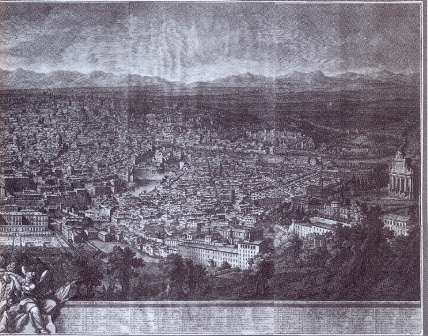
Guiseppe Vasi i.s.m. Giambattista Piranesi. Prospetto dell’alma citta di Roma visto dal Monte Gianicolo (1765) [3]
But aside from a robustness keeping a city together, and the ‘impossible’ reason for a revolt by people and architects, but also others, including engineers and builders, to make things possible, such defiance of the odds was not the only reason for the downfall of cities.
In reflection of cities in history and of the varied reasons for their downfall, and despite all kinds of hardships and many shortcomings, no city can ever be defeated unless broken in its own free spirit. That was the case of Constantinople despite having impregnable walls, but only until Turkish troops had managed to enter the city through a small side door left open by mistake. Once the defenders of the city saw these Turkish troops, they gave in. Although so few in numbers that they could have been easily ousted, a shout of fear spread immediately throughout the entire city, the fear that the Turks had taken it.
Another way of capturing self defeat is how Rodin portrays in his sculpture of the citizens of Calais how they sacrifice themselves by handing over the key of the city to the invaders in order to save at least the city from being razed to the ground and with it all its inhabitants killed.
There is always hubris in history. Lewis Mumford hints at it when saying it is in vain if some try to become more sophisticated in the organization of things than what the city is capable of doing by itself. For he believes no conscious organization comes ever close to what a city as a whole manages to do throughout time. Hence the story of the city continues only according to Lewis Mumford, if that complexity is heeded. [4]
Naturally that complexity needs to be and is being broken down in the way a city organizes itself by giving distinct functions specific meanings. But by attempting to do so, there has to prevail a sense of freedom even from being over organized and merely efficient. Freedom cannot be given to the citizens solely by the market staying free i.e. from interferences, but only if the city as a whole is free to recognize limits to its organizational potentials, can the people make a big difference to everything else. That sense of positive freedom shall be upheld as long as justice and fair distribution of not only goods and services, but also power prevails. What then characterizes life in the streets leading up to the Agora is a good indication of governance and level of citizenship.
No wonder then that the entrance to the Agora was marked by a special monument: the tower of winds. But before coming to the role of monuments in cities, something needs to be said about those times when the Agora flourished underneath the Acropolis in Ancient Greece.
Clearly the Agora was then the heart which kept Athens alive. It could be recognized by the human voices heard in the streets and especially at its most central reference point, the market place.
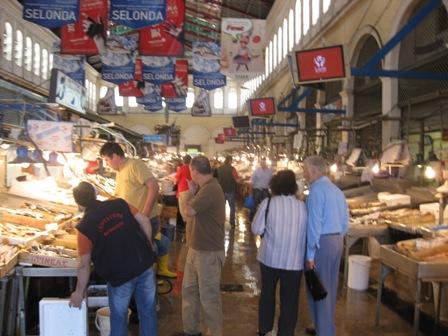
Central Fish market of Athens 2010 @hf
The human voices bring a city to life. It is something which prevails till today. In his book about Ancient Greece, Robert Payne wrote:
“By common consent there was one place louder than all the rest. This was the Agora, where every morning until midday the Athenians did their marketing. Here, beside their small stalls and booths constructed out of matting, wickerwork, and a few boards, the merchants vied with one another in producing the largest volume of sound. We are told that the fishmongers were the loudest, the most obscene, the most quarrelsome, and the most adept at giving short weight, but the shrill voices of the myrtle sellers were nearly as loud. Sprays of myrtle were plaited into wreaths and coronets, to be laid on graves or presented to the gods. Pricked out with flowers they were worn on the brow or hung on the doors of houses The myrtle sellers were the loudest and coarsest of the women in the market place, and for a suitable fee they could be induced to serve as flute girls or prostitutes. Even louder than the fishmongers and the myrtle sellers was the terrible voice of the herald who would order the market place cleared so that everyone could attend the Assembly. Then the great rope painted with fresh scarlet paint would be swept across the market place, and anyone seen wandering around the streets of Athens with a smear of red paint would be fined, for not being in attendance at the Assembly.” [5]
But to come back to the question of the monument, after two world wars the historian Kosselek and others took up a reflection of these evidences that war had taken place. Within the subject field of political iconography the key question was whether or not monuments tend to glorify war as opposed to being sober, reflective and even questioning war due to all the atrocities it causes? There are famous monuments linked in Europe to the wars of 1871, 1914-18 and 1939-45. Often these monuments are sacral places. No one is allowed to alter their interface with history. Only lately this has been changing. For instance, the artist Jochen Gerz near Monpazier in Southern France undertook it to interview all kinds of people about what they remember of First and Second World War and then asked them for their opinion about war in general. He took quotes out of these interviews and pasted them on a monument commerating First World War by fastening on them little plates.
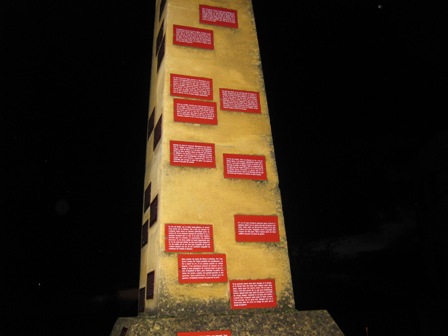
Jochen Gertz's monument near Monpazier, Southern France @HF
Ever more political can become a monument when it remembers the killing of a 15 year old boy by a policeman in Athens on 6th of December 2008.
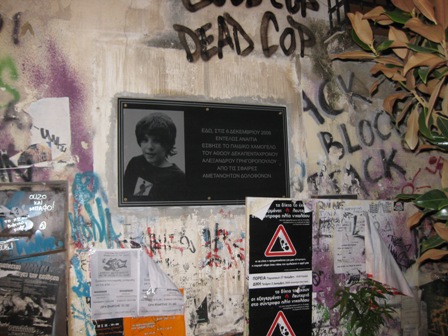
It set off a wave of protest with streets burning and shop windows smashed. Jean Paul Sartre interpreted that as an attempt to break into the present. It is as if an entire younger generation is suffocating under all the corruption and negative role models their parents and the older generations portray. They break glass out of desparation when without any air to breathe. By 2010 this memorial has become a rallying point for many who live in open opposition to the system and who seek another life style free of hierarchies to be found in organisations like the police. Social unrest but also the turmoils caused by different attitudes and values linked to survival strategies require a new interpretation of cities in the 21st century if they are to face up to these new challenges.
Cities of the 21st century
Then to leap into the end of the twentieth century and beginning of the twenty-first century, cities started to depart from a central square linked to the market place. They started to adopt to the topology of American cities with no clearly identifiable centre left and retail business located to outskirts. Therefore, it was of no big surprise when European cities followed suit, but it was a sort of shock when the famous ‘les Halles’, the central market of Paris, was abolished and relocated to the outskirts of the city. The poet Baptiste Marray felt as life of the city had been exported. The gap was filled in part by Centre Pompidou, a new kind of flagship for the cultural industry, while the space around it has no longer that living vitality but reflects much more the struggle people face in Paris when they wish to exist between all and no possibilities.
Lately the journalist Roger Cohen wrote in the International Herald Tribune (8.12.2008) that Paris has become nearly unrecognizable. Gone is for him that special unity made possible by a kind of squalor shared by all. He would include the Clochards and what some would describe as a romantic touch, especially if men and women would enjoy a robust cultural life with everyone smoking Gauloises and airing philosophical questions answered by painters like Modigliano with a portrait of Alice.
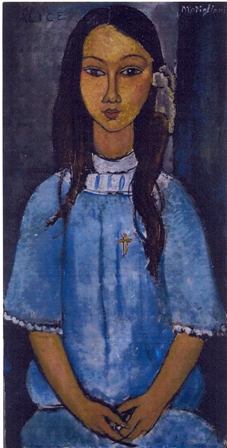
Modigliani: Alice [6]
By comparison to the past, modern or more precisely post-modern Paris seems to have lost all that Romantic squalor and with it apparently the ability to say ‘no’ to all kinds of false pretenses about life. Yet again Paris has so many sides and facets to it, that it cannot be so simply generalized. While there are obviously the poor suburban districts which lead to uprising by especially the radicalized youth with Algerian and other cultural backgrounds which do not allow them to fit into French culture so easily, there are other neighborhoods which flourish and continue to interweave life with many forms of expressions all taken to the next levels of sophistication. Still, the city has to cope with all kinds of traffic problems and an urban population of a varied and mixed background, while modern demands make city officials allow for new bicycle schemes to alter the ways of getting around. There have also been converted many former halls used in the past by the central market to sell meat and other agricultural products into artistic and cultural display centers, then this modernization underlines an amazing arsenal which Paris has all as its disposal.
Still, there is a need to gauge how life in cities of the twenty-first century continues. For instance, when life in that part of the city is compared to what prevailed before ‘les Halles’ were removed and replaced by a flagship of the cultural industry called ‘Centre Pompidou’, then the conversion to a cultural economy linked to tourism becomes apparent.
Centre Pompidou by night with the structure of stairs illuminated as part of an industrial design meant to make the building more transparent or to look like an innovative environment.
With it comes to mega exhibitions or else famous collections which are exhibited in large halls whose structures resonate still with their intended past, namely to be a mere parking garage, value is lost. Arbitrary use of space or making use of space in a multi-functional way shows itself by a building not being committed to a specific purpose, as was the case of the Cathedral when the church took up the high grounds beside the market in a city. All that alters appreciation of the arts and reflects what new laws govern in terms of what takes on value over time. Interesting are therefore the kinds of displays; most installations work with fleeting moments of images, as if everything is to be brought into flux or to be guessed as if in Plato’s cave.
Governance on the basis of lived life taking on value over time has to include the kind of information needed in order to know by which laws citizens abide to. If not everyone abides to the same laws, and no new constitution can be agreed upon as common source of values upholding such a legal system, then arbitrary rule will be the case with a poor man being hung for stealing an apply while a rich man will walk free despite having killed a slave or simple woman. This was already the case in Ancient Greece, did not prevent Goethe from passing the death sentence of a young woman for having killed her illegitimate child and is noted to be repeatedly the case when common convicted people have not the money to pay off expensive lawyers while those who can afford them walk free. The philosopher Michel Foucault understood this as the failure of a practical discourse to facilitate the writing of a new text. By letting arbitrary rule continue, it will risk uprisings and revolts as was the case with the French Revolution starting with the storming of the Bastille in 1789.

Storming of Bastille 1789 [7]
Of great interest is what has become of this famous square in Paris since nowadays there is almost nothing which reminds of what was feared by everyone in those days. The Bastille was back then the most terrible institution and all common people dreaded to be imprisoned there one day for no apparent reason. Consequently a city must give to the ‘la raison d’etre’ – the reason to be – a context to live and to work out what it means to be not merely alive, but well and happy as a citizen like everyone else and above all free to move about, to trade and to engage in all sorts of activities. It cannot be that life is standardized according to but specific norms which those who impose them do not even respect, never mind honor themselves when going about their own business.
After all these historical experiences, with cities experiencing repeatedly violent protest waves threatening in the end all kinds of institutions and at the same time destructions from outside (and above i.e. air bombardments), a still to be articulated urban philosophy can be considered as direct outcome of repeated failures in history. While the need to govern a city through active citizenship was stressed already by Pericles in his funeral speech when Athens was still great, but on the verge of self destructive adventurism by entering a war with Sparta, such democratic governance has been made most difficult, if not nearly impossible by a flawed distribution of power, corruption and structural socio-economic injustices have overburdened the civic structures in need if social and economic cohesion is to be upheld.
A market is determined as much by what can be brought to the stands as by taste and what those having money want to purchase. Purchasing power is an important term and can explain how the flow of goods and services is governed. Those cities left on the wayside have little influence upon overall economic developments. Consequently a city needs a kind of Agora alive with bustling people willing and capable to undertake all kinds of activities. When it comes to selecting and buying things, there is a knowledge created by cooks who know which fish they want and by housewives who know which vegetables they want for cooking a soup. Amongst the crowd mingling around the stands are thus all kinds of people, direct and indirect servants included. Therefore the life at any market is a reflection of what layers make up society.
In that sense a sophisticated use of food has always a connotation of the rich when in fact the poor and simple folk can acquire as well a taste for certain things and which takes on over time a cultural meaning, that is as something more than being a mere stable food. Good bread, cheese and a bottle of red wine can be altered with some olives and tomatoes and out of a simple life can emerge a beautiful one. Vincent Van Gogh painted the potato pickers and in so doing gave them an aesthetical beauty despite hardship being stressed by eating with the very same hands they work the land with to pick the potatoes.
Naturally the prime concern of any city is to ensure through the Agora that certain standards are upheld. These include guarantees that only healthy food reaches the dinner tables; food and health standards were not kept for example in Chicago which prompted Upton Sinclair to write about the slaughter houses as source of a huge scandal. Life is not something to be squandered by bad food or by indulging in all kinds of manipulations as the case with Chinese cheaters using fertilizer to boast the apparent protein content in powdered milk. The fact that things are stretched to make more money than what is being delivered in reality, against these practices only honesty can help, that is a kind of culture which values delivering things in a straight forward way rather then cheating people out of their money. It cannot be stressed enough that such honesty as cultural value is invaluable for any city in both the short and long run. And not police but culture is needed to uphold such honesty allowing for people to control each other informally rather then resorting to formal authorities leading to all kinds of ill fated practices and wrongly conceived punishment systems. It was crucial even for people working at the City in London that everyone took care not to damage the reputation of the name of the bank they were working for. By opening up the City to newcomers as did Thatcher was in reality an invitation for such ill conceived practices aiming to make a lot of money within a shortage of time rather than taking care to uphold the reputation by staying honest.
The historical monument plays a complex role in society. Piranesi links the monument in the city to the kind of monument wars left behind. All weapons from both the defeated and the victorious ones were heaped up and left behind. It was an interesting way to document the end of that war.
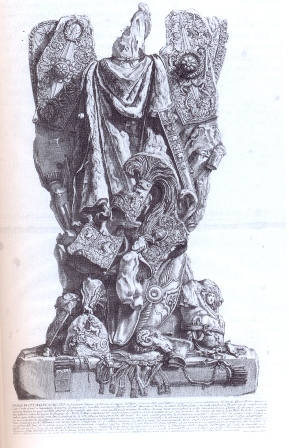
War Monument by Piranesi
Unfortunately many monuments do not remember war, but have become too often a rallying point for patriots and war veterans, and more so departure points for those who wish to wage war again. The Futurists glorified already before Heidegger that only in a struggle, fight or war the true being is revealed. War as antidote to boring life meant really looking upon the slaughter of people with a most deceptive eye to make killing appear as if entering a huge adventure.
In terms of political iconography, many monuments do not provide necessarily impulses for sober reflections about the reasons for war. Most controversial is, for example, the ‘Voelkerschlachtdenkmal’ (people’s battle monument) in Leipzig. It was build to remember the victory over Napolean and build out of donations by the people themselves, but it was most decisive for First World War as it was inaugurated in 1912 and stroke the fire of enthusiasm for going to war without anticipation what cruelty would await all the soldiers alone in Somme or else at Vimy Ridge. Still today Verdun is a landscape filled with scars of the war.
The monuments linked to First World War have been for Andre Breton an expression of suppression of memory. Of interest is that Sarkozy, President of France, would call during memorial services in 2008 those French soldiers who refused to shoot no longer cowards, but considers them to be heroes of their own accord. As Andre Breton would explain soldiers began to exchange information and therefore drew conclusions about the useless of this war which slaughtered the common soldier without regard for human lives. Ever since then monuments in French towns attempt to tell a glorious story. They do so at the cost of suppressing a bitter truth about war and its ramifications. Yet today efforts are made to bring about another historical understanding due to Germany and France having joined the European Union which attempts to draw lessons out of that terrible past which destroyed all beauty (Paul Klee) and shaped European life in cities since 1945 when the Second World War ended.
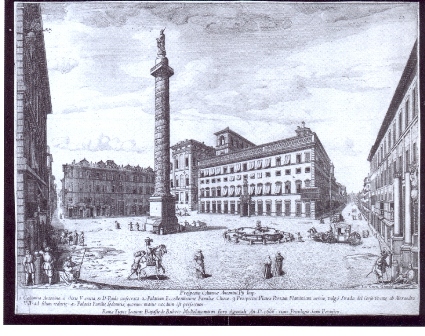
Fig. II.50 Lieven Cruyl, Prospectus Columnae Anonini Pij Imp. (1666) [8]
If anything, the development of the city around a square with a monument in place has always been at the core of visions. No one took up this theme by Piranesi more precisely then de Chirico. It is telling that the vision from inside the city towards what lies outside could remind of Parmenides poem describing how an urban dweller leaves the city to step through the gate of fate outside and thereby into nature to unify again the senses very differently.
In the city the senses are exposed to a kind of abstraction. That was indicated by the need of mankind to escape violence in wild nature but also the violence between cities and later on countries. Thus the yearning for a life above sheer necessity entails an urban concept. That is linked to the quality of life anyone believes to enjoy in a city compared with a village or in a remote area.
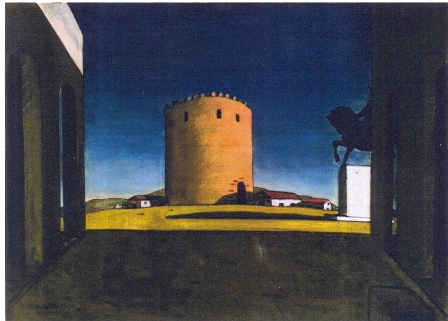
De Chirico: Red Tower (1913) [9]
De Chirico’s perception of monuments in squares was certainly influenced by visits to cities like Rom and by Piranesi. Bart Verschaffel wishes to draw that line of though and artistic development as it shows how places have become due to the artistic perception of things a part of urban metaphysics. It was the Surrealist outreach. Always something is juxtaposed as to what is supposed to be reality in terms of order, time and space. Human beings need to give themselves space.
However, artists rarely know how to use space, according to Herbert Distel, founder of the museum of drawers. Negative and positive spaces as often depicted in paintings are in reference to one another just one aspect of this overall contemplation about how to discover and to fill the spatial dimensions. Another problem seems to be linked to the wish to unify tangible and intangible things by referring to one space capable of spanning the difference between the material and immaterial. That was already the case when Picasso and the Cubinists started to depict air considered till then as something invisible. Naturally perception leading to further questions as to what the eye can see was problematised by philosophers like Husserl and did not end with Martin Jay’s “Disenchantment of the eye”. Equally political wishes were transformed into repressive political utopias based on the idea that the state must get eyes to know what is going on. That is a specific reactionary response to uncertain times. It has always something of a conflict with life and death or as Hegel would designate death as the ‘unmoved mover’, thereby questioning movements per say as not really to be true to the content they claim.
In his disquieting muse juxtaposition expresses the contrast between movement and no movement, between figures playing on the chessboard of the city their games while their faces are hardly distinguishable from the monument in the background but which has oddly a more humane face. In Greece poets would sing about that statue which could step down after midnight to cross the platia and join those who stay up late.
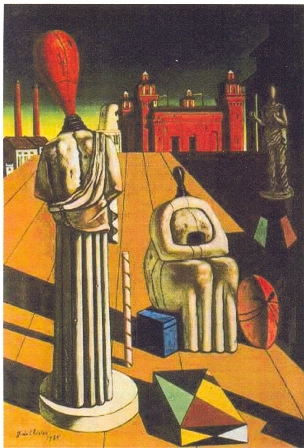
De Chirico, Disquieting Muses (1916)
Metaphysics is not only a reaffirmation of urbanity but relies on industrial production as indicated by the chimneys of the factory in the background and this beside the administrative and political centre bearing all the trademarks of a palace, justice building and bank. All of them strive to be monumental with all the tragic flaws it entails.
8.1 Squares and places
Modern squares deal with urban reality in quite another way. They show primarily the outcome of bad decisions at city level when planners, administrators, security people etc. attempt to conceive something together but which has no bearing at all as to what the people at that location have lived and experienced.
Kolonaki Square in Athens (rebuilt for the Olympic year 2004) @hf
The Labyrinth like construction of Kolonaki Square
Often squares are domesticated places but without life. In Athens Omonia square used to have a good meeting point but this has vanished after repeated attempts to tame that wild place within the city. It leaves the squares begging for breathing spots only to be spotted if there is life and not a mere parking spot while people pass by without dwelling. In a hectic city with everyone running no one seems to have time to stop and to sit down.
8.2 Breathing spots
In discussions about Athens there is repeatedly pointed out that the city has too few breathing spots. Cramped, since built up very quickly and without any clear plan due to first waves of immigrants from Asia Minor and then people from the islands seeking in the capital employment, the city expanded and urbanized precious land without regard for public spaces. Pavlos Delladetsima maintains that there is a coalition of interests which prevent the city taking the initiative on behalf of public land. Most of the time the excuse and explanation is lack of money while waves of privatization leave the city chocking on lack of space. It is naturally a combination of pressure by the housing market on land and lack of aesthetical principles which leads to a wild expansion. Regardless of its built heritage, the city destroyed old houses to make way for the new. Most of the time it meant classical buildings with gardens are replaced by four and five storey high apartment blocs. For example, building speculation has put pressure on the remaining houses which are preserved by good luck due to people not selling their houses, whereas the contrast could not be stronger when suddenly the elevation jumps from one storey to five story houses.
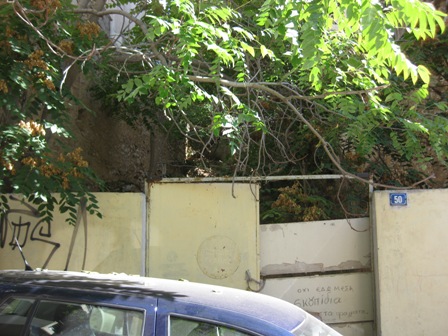
Untouched land @HF
Breathing space has a lot to do with not covering the earth. This is not possible when 100% of the plot of land is being built upon. One compensation can be to pretend to have such a space required by law. This is done to plant an olive tree on top of the built area and besides the entrance of the parking garage underneath the house.
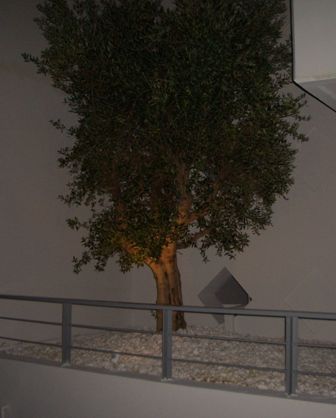
One olive tree on Dafnomili Street, Athens
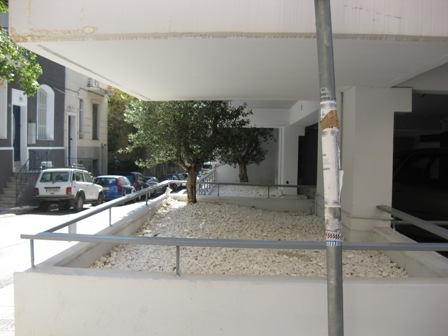
The two olive trees virtually underneath the house and planted on artificial ground
8.3 Encounters at certain places: Trafalgar square or Times Square
Once certain encounters become possible in, for instance, Trafalgar Square in London, then that place will be remembered not for the figure Trafalgar standing there as a historical monument, but at personal level. Philosophers would say there is a difference when encounters in time are experienced subjectively, compared to objective time as measured by scientists and still different from historians who record time over time. It is a matter how memory and meaning are linked or attributed to a certain place remembered by encounters taking place there.
To illustrate that point, a student sat down once on the stairs leading up to the National Gallery and in so doing encountered another person. That other person entered his life briefly but quite decisively. He was then a student at London School of Economics at that time and she an art student from Holland. She had come to London with her school on a study trip. He became attentive to her from the back as she sat down close by. It was her spine to be traced underneath a woolen garnet of blue and grey she wore. It was that sensitive line which spoke to him right away for it reminded him of his mother whom he had massaged often on her spine due to acute back pain. When he addressed her on the basis of that feeling, she responded immediately. They entered a lively discussion about philosophy of the arts. She was curious to learn about new aesthetical theories she felt in need of for her studies and her art works. Her interest opened for him a way to speak about Adorno’s theory of aesthetics he had never done before.
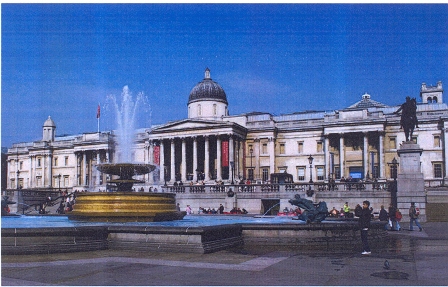
Trafalgar Square [10]
The time of that first encounter with Philippine Herring was autumn 1969. Adorno had just passed away. Since he left his aesthetical reflections unfinished, guidance was needed on how to complete incomplete thoughts. She wanted to know also about a good music shop since she was interested to buy Baroque musical score as she played the flute. And she put like Vincent Van Gogh a lot of emphasis on drawing. Later Philippine Herring became a famous painter and drawer who made with Rudolf Gorbach children books. As to the impact upon her life due to that encounter, it altered her life. Upon returning to Holland, she divorced from her husband because she felt to commit spiritual adultery by continuing to think only about this student she had met on the stairs of the National Gallery. Such a first encounter cannot be called a coincidence. Rather it is an encounter which takes on meaning or not for all depends on who is involved and what results out of it.
For a long time thoughts about encounters in streets were linked to the barricades constructed by striking workers or prior to the Industrial Age to those who initiated the French revolution in the streets of Paris. Viktor Hugo would describe some of the scenes with people hovering behind barricades as awaiting not only an encounter with the police but with history. Such literary reflection marks moments in history as encounter with power which attempts to re-draw the lines as to who is to be subjugated by power and who has the power to overturn power. Encounters with forces of history leave forever memories in the streets as to those revolutionary times.
It is another matter once encounters are planned to take place at Times Square at the turn of the millennium. It is a modern way to remember where one has been at that time. More then strict amusement but less then a historical encounter, it is done in order not to forget where one has been at that hour.
That then touches upon how to remember on the basis of which encounters? The dance company Jasmin Vardimon displays, for instance, in its performance ‘Yesterday’ that encounters cannot be reduced to the meeting of two forces at physical level. Once memory is in play by asking ‘try to remember’, then encounters are only possible if something else comes into play. Memories are there to ensure continuity but also recollections. It is a way to use an encounter in order not to forget. Sometimes such encounters can become frightening as if just meeting one’s own shadow while the city becomes a stage on which all kinds of encounters take place daily and no one sure which one of the many really matters. That then is a matter but which image is to linked to what memory. The dance company uses for this point of illustration an encounter with, for instance, death when shooting takes place and a figure vanishes but its traces remain present on a different medium: a projection screen of the image of that person. This contrasts to the real physical presence of the dancers and makes the sense of illumination become important to steer the encounter towards the efforts to remember. Thus images projected upon a silk screen or a bulletin board in Times Square can leave traces behind. But as the thrill and excitement of the happening fades away, so the magic light shining upon the event goes out.
The importance of this fading out is that certain places like Times Square create their own aura. People encountering themselves and others at that place feel as if linking their own real time with historical time. This illusion is created by the latest news being run over the tickers while the crowd mingles below curious to find out what is going to happen even if nothing happens. Obviously it is enough to encounter the emptiness of the world at that location since presumed to be the first one to know what is going on in the rest of the world.
Times Square [11]
Naturally such encounters would not be meaningful, if the key messages of the current times are replaced by the ever presence of certain products by means of advertisements on large bill boards or electronic screens. It leaves no doubt as to what dominates in this commercial world based on consumption and product placement even and especially at those places of encounters.
8.4 Interfaces within the city: urbanity
Urbanity defines itself as being at home despite the existence of different levels making interfaces often into a dialectic between illusion and disillusion. Whenever such perception of mankind alters from being casual to undertaking something serious, then the intermingling of people en route to various tasks is no longer innocent. It can be the child looking up to the parent in order to know when crossing the street is possible while the adult perceives in between cars driving past a wave of people unknown. Neither their past or their future is known and yet they need to be trusted if a way is to be found through the crowd.
Recent problems in Holland have reiterated this cry for “the street belongs again to me”, as if cultural belonging to one and the same society governed in a certain way means no longer to tolerate parallel societies. At least this is the expression of Labor in Holland in view of no longer wishing to have side by side a tolerance with women wearing burkas while other women express the emancipation process, including the wearing of a dress of their own choice and not something expressing an imposed religious code for dress and behavior in public.
Quite another interface is when protesters meet the police and therefore force into the open, in the streets, the symbolic order of the state. Once protest and repression unfold, then discontent on the side of the protesters provokes a variety of responses from the citizens. It can become an explosive mixture till confrontations are answered with the police using its power to hit back at the demonstrators.

Demonstrators and police in Athens 2010
[1] Davoudi, S. and Strange, I. (eds) (2009). Conceptions of Space and Place in Strategic Spatial Planning, London: Routledge (RTPI Library Series)
[2] Bart Verschaffel (2008). “Piranesis. The print collection of Ghent University”. English Text for the Catalogue to the Exhibition at the Museum of Fine Arts Ghent, 20.9.2008 – 18.1.2009
[3] Op.cit. Exhibition catalogue of the Piranesi Exhibition at Museum of Fine Arts Ghent p. 165
[4] Lewis Mumford (1991). The City in History. London: Penguine.
[5] Robert Payne (1964). Ancient Greece. New York: W.W. Norton & Company, p. 255
[8] Piranesi. The Print Collection of Ghent University (2008). Edit. Bart Verschaffel Exhibition at Museums of Fine Arts, Ghent 20.9.2008 – 18.1.2009. Ghent: MSK A&S books, p. 141
« 7. Orientation: living, traveling and strangers coming into town | 9. Cultural infrastructures »

